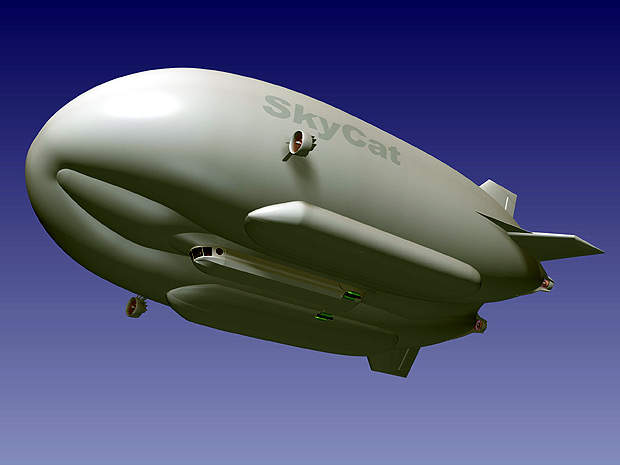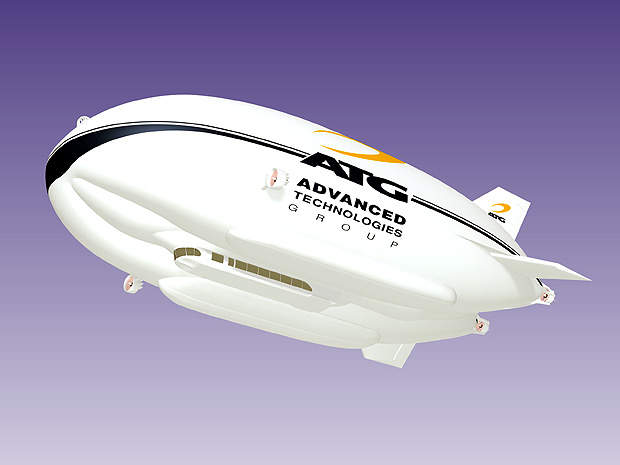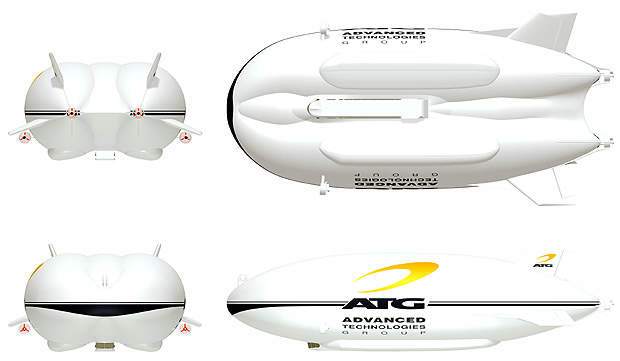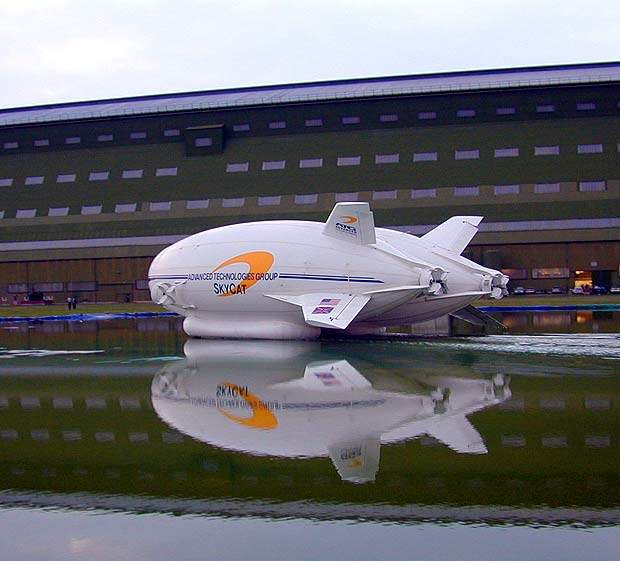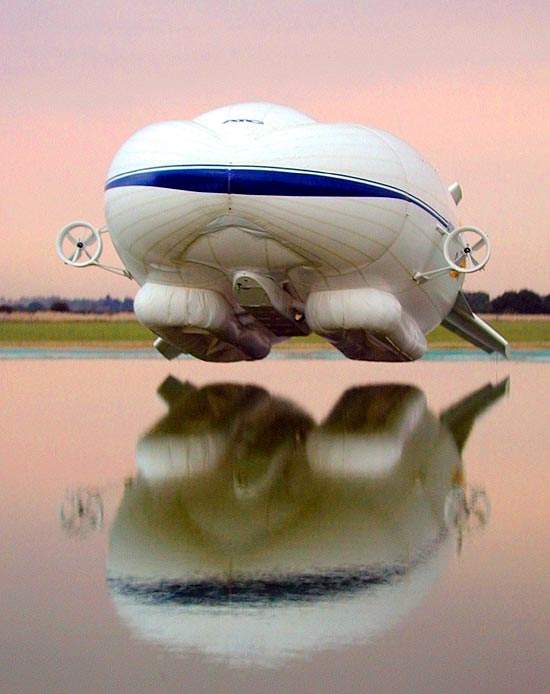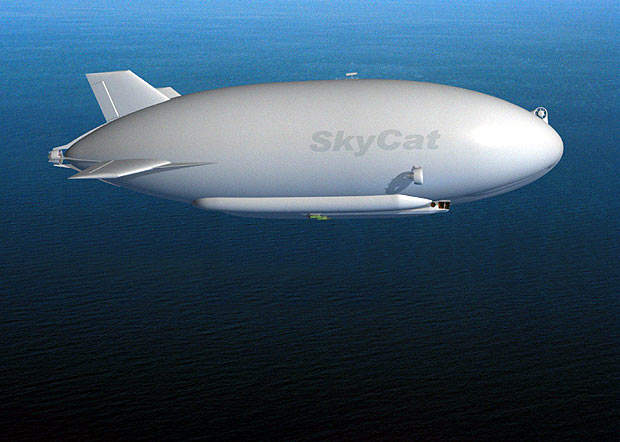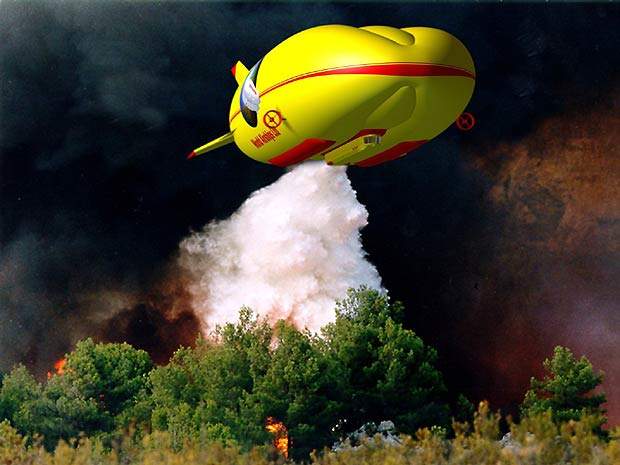The SkyCat hybrid air vehicles, supplied by Advanced Technologies Group, based in Cardington, Bedfordshire, UK, combine lighter-than-air airship technology and air-cushioned hovercraft technology. The vehicle will be built in three variants, the Skycat 20, 200 and 1000 with payload capacities from 20,000kg to 1,000,000kg. The first SkyCat will be the SkyCat 20 for which the first flight is anticipated in 2006.
In July 2005, the Advanced Technologies Group Ltd went into administration under Part II of the Insolvency Act 1986. The future of the development programme of the SkyCat is thus uncertain.
The air cushion landing system allows the vehicle to land on flat land, grass, swamp, snow or on water, giving the vehicle fully amphibious capability. The landing system also allows the airship to land without the normal lighter-than-air airship ground crew and ground landing infrastructure.
The SkyCat can be configured as a passenger airship, an ultra heavy cargo ship and as an airborne surveillance platform. Military applications include tactical and strategic air lift, a command, control, computers and information platform, mine countermeasures, airborne early warning and anti-surface warfare.
SkyCat design
The SkyCat layout includes an advanced lifting body, an ellipsoidal-shaped cross section hull and a catamaran-hover-cushion system. The development of the SkyCat is based on the proven successful design, manufacture and operation of the fleet of airships by Airship Technologies, which designs and operates more transport and passenger airships than any other airship operator worldwide. The maximum operating altitude is 2,745m.
The envelope structure incorporates a laminated fabric envelope. The envelope is a large bag containing the lighter-than-air helium gas which provides the airship with much of its lift. Helium is an inert gas which is not flammable. The payload module is built on the centre line of the airship. An internal catenary structure supports the payload. The envelope shape is supported by an internal configuration of diaphragms, which can be used to compartmentalise the structure.
The SkyCat has a patented ATG bow-thruster that allows the direction of the nose to be accurately controlled at low speeds, dispensing with the need for large numbers of ground crew.
SkyCat 1000
The largest variant of the vehicle, the SkyCat 1000, has a maximum payload capacity of one million kg, which is nearly ten times the capacity of a Boeing 747-200 freighter aircraft. The cruise speed of the SkyCat 1000 is 185km/h, which is a fifth of the speed of the 747. The range is 7,408km compared to the 747’s 8,700km range.
The first flight of the SkyCat 1000 is scheduled for 2008. The mission of the SkyCat 1000 as an ultra heavy lift air vehicle has been assessed by the United States Army in a study initiated in 2001.
The main cargo deck provides 195m² (2,100ft²) of clear loading space. The deck is fitted with a military load rated floor. The area above the door aperture provides an additional 195m² floor area and a number of mezzanine floors can be installed to provide additional deck area. Roll on/roll off ramps are installed in the fore and aft of the airship allowing fast and efficient embarkation / disembarkation to the cargo area.
SkyCat 20
The main cabin of the SkyCat 20 is 22.3m long by 3m wide and is fitted with four passenger seats The cabin has a large side door with integral steps and a full width rear cargo door.
The SkyCat 20 carries a maximum payload of 20,000kg. The cruise and maximum speeds are 130km/h and 148km/h respectively. The maximum payload range is 2,250km. The ferry range is over 7,400km.
The SkyCat 20 development program was completed in 1999 and manufacture was started in 2000. SkyCat 20 will enter service with World Airships (UK) in 2005/2006.
SkyCat 200
The SkyCat 200 cabin is 49.4m long by 7.5m wide and is equipped with a rear roll on/roll off ramp. There is space for an additional 37m² of floor area above the door aperture.
SkyCat 200 carries a maximum payload of 200,000kg, about 80% more than a 747 freighter payload. The cruise speed is 139km/h and the range is 5,970km.
SKYCAT FLIGHT DECK
The flight deck accommodates two pilot stations which are fitted with conventional stick controls. The pilots have an exceptionally wide and deep field of view through the large transparent windows. The flight deck can also accommodate off duty flight and cabin crew or training crew members with 18.6m² of floor space available on the SkyCat 200 and 83.6m² floor space in the SkyCat 1000.
The dual-channelled optically signalled flight control system is based on fibre-optic technology or “fly-by-light” to send signals to the powered control actuators.
SkyCat Landing system
The air cushion landing system is derived from hovercraft technology with hoverskirts installed on the underside of the outer hull section. The hover skirts are held flat against the hull by the air pressure which gives the hull an aerodynamic profile during flight and also allows an all round view from the cabin. The hover skirt and the hull pressure system are operated by the ballonet fans.
SkyCat Engines
The SkyCat 20 is powered by four ATG A-Tech 600 direct injection diesel engines rated at 447kW. The larger SkyCat 200 is equipped with four 5,996kW turboshaft engines. The engines are installed in ducts with two engines on the forward hull and two engines on the rear hull. Blown vanes in the ducts provide the vector thrust for take-off, and landing and for manoeuvring on the ground.
The SkyCat 1000 is powered by six turboshaft engines, each rated at 11,185kW. One engine is installed on each side of the forward hull. Two engines are installed in the stern duct on each side of the hull with each engine driving a single propeller.
The ship is equipped with a 28V DC electrical power system and a low pressure pneumatic system. The pneumatic system powers the flight control actuators. The pneumatic system provides very low susceptibility to lightening strike.

